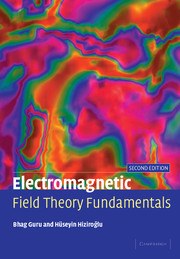Book contents
- Frontmatter
- Contents
- Preface
- Acknowledgments
- 1 Electromagnetic field theory
- 2 Vector analysis
- 3 Electrostatics
- 4 Steady electric currents
- 5 Magnetostatics
- 6 Applications of static fields
- 7 Time-varying electromagnetic fields
- 8 Plane wave propagation
- 9 Transmission lines
- 10 Waveguides and cavity resonators
- 11 Antennas
- 12 Computer-aided analysis of electromagnetic fields
- Appendix A Smith chart and its applications
- Appendix B Computer programs for various problems
- Appendix C Useful mathematical tables
- Index
2 - Vector analysis
Published online by Cambridge University Press: 05 June 2012
- Frontmatter
- Contents
- Preface
- Acknowledgments
- 1 Electromagnetic field theory
- 2 Vector analysis
- 3 Electrostatics
- 4 Steady electric currents
- 5 Magnetostatics
- 6 Applications of static fields
- 7 Time-varying electromagnetic fields
- 8 Plane wave propagation
- 9 Transmission lines
- 10 Waveguides and cavity resonators
- 11 Antennas
- 12 Computer-aided analysis of electromagnetic fields
- Appendix A Smith chart and its applications
- Appendix B Computer programs for various problems
- Appendix C Useful mathematical tables
- Index
Summary
Introduction
Knowledge of vector algebra and vector calculus is essential in developing the concepts of electromagnetic field theory. The widespread acceptance of vectors in electromagnetic field theory is due in part to the fact that they provide compact mathematical representations of complicated phenomena and allow for easy visualization and manipulation. The ever-increasing number of textbooks on the subject are further evidence of the popularity of vectors. As you will see in subsequent chapters, a single equation in vector form is sufficient to represent up to three scalar equations. Although a complete discussion of vectors is not within the scope of this text, some of the vector operations that will play a prominent role in our discussion of electromagnetic field theory are introduced in this chapter. We begin our discussion by defining scalar and vector quantities.
Scalar and vector quantities
Most of the quantities encountered in electromagnetic fields can easily be divided into two classes, scalars and vectors.
Scalar
A physical quantity that can be completely described by its magnitude is called a scalar. Some examples of scalar quantities are mass, time, temperature, work, and electric charge. Each of these quantities is completely describable by a single number. A temperature of 20 °C, a mass of 100 grams, and a charge of 0.5 coulomb are examples of scalars. In fact, all real numbers are scalars.
Vector
A physical quantity having a magnitude as well as a direction is called a vector. Force, velocity, torque, electric field, and acceleration are vector quantities.
- Type
- Chapter
- Information
- Electromagnetic Field Theory Fundamentals , pp. 14 - 69Publisher: Cambridge University PressPrint publication year: 2004
- 1
- Cited by

